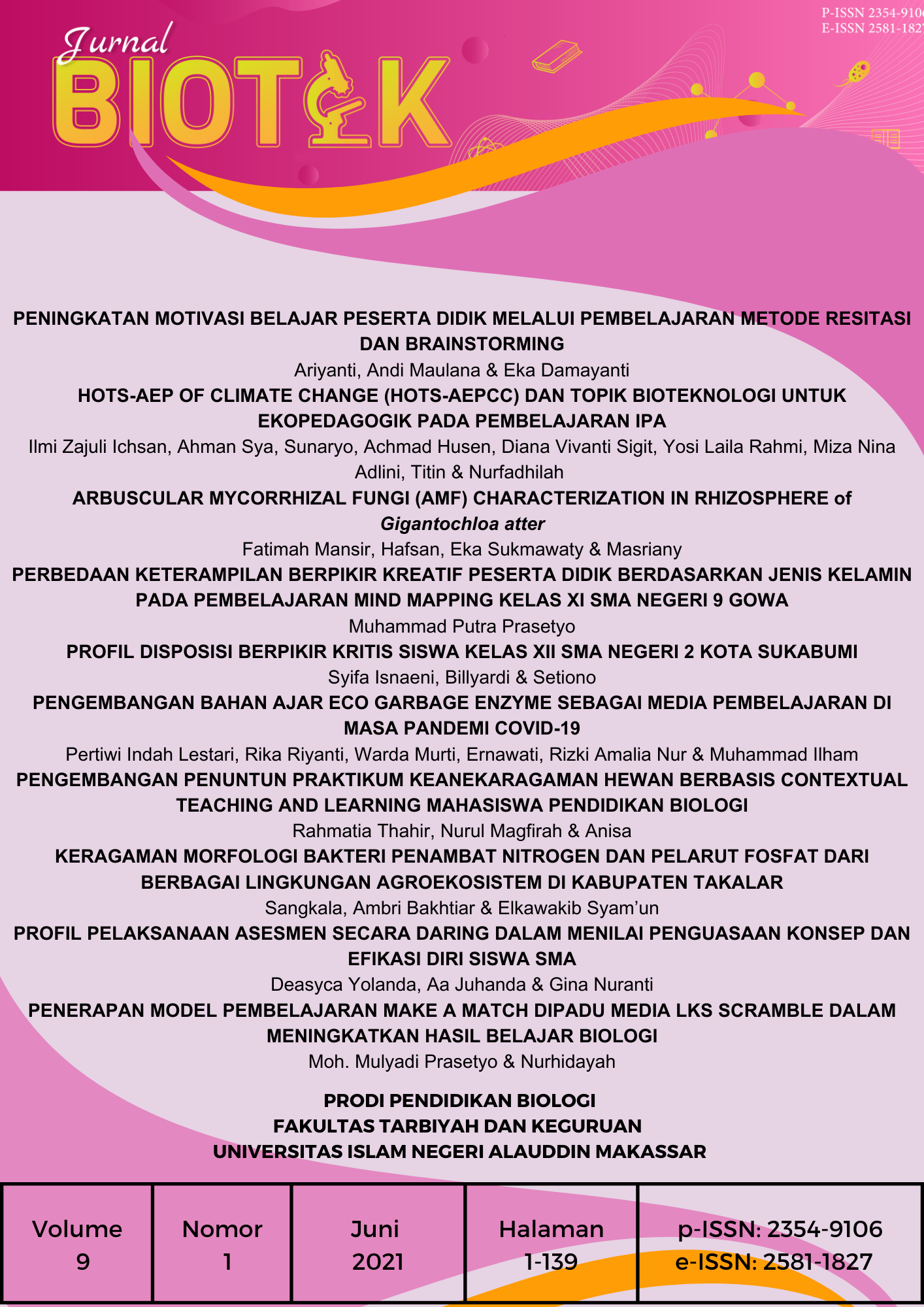PENGEMBANGAN BAHAN AJAR ECO GARBAGE ENZYME SEBAGAI MEDIA PEMBELAJARAN DI MASA PANDEMI COVID-19
Abstract
This study aims to develop teaching materials for eco garbage enzymes as learning media. The product produced was teaching materials for making eco garbage enzymes of liquid organic fertilizer. The research model employed was the 4D model, which comprises four stages, but only the development stage used in this study. The instruments used in this study were validation sheets and questionnaires to measure the validity and practicality of the developed eco garbage enzyme products.Two experts validated the product then analyzed it on the Gregory test. The value obtained was 1, which means the product was valid and feasible to use. Based on product used observation, the practicality value showed 4,6 means the product had used as a whole. According to learning outcomes, the product effectivity was 78.25 % in the high to very high categories (completeness equal to 75%). In addition, the positive response from students was 94.09%, this indicates that the teaching materials are effective to use as learning media
Downloads
References
Aditia, T. (2013). Pengembangan Modul Pembelajaran Berbasis Sains, Lingkungan, Teknologi, Masyarakat Dan Islam (Salingtemas) Dalam Meningkatkan Hasil Belajar Siswa Pada Konsep Ekosistem Kelas X Di Sma Nu (Nahdatul Ulama) Lemahabang Kabupaten Cirebon. Scientiae Educatia, 2(2). Available at: https://syekhnurjati.ac.id/jurnal/index.php/sceducatia/article/view/478.
Depdiknas (2002) Teknik Belajar dengan Modul. Jakarta: Dirjen Pendidikan Dasar dan Menengah.
Dharma, S. (2008) Pendekatan Jenis Dan Metode Penelitian Pendidikan. Jakarta.
Fajar, T. (2020) Arti belajar di rumah di tengah wabah virus corona, Okezone news.
Iriani, R. (2019). Modul Pembelajaran Problem-Based Learning Berbasis Lahan Basah untuk Mempersiapkan Calon Pendidik Berwawasan Lingkungan Lahan Basah., Inovasi Pendidikan IPA, 5(1), pp. 54–68. Available at: https://journal.uny.ac.id/index.php/jipi/article/view/23337.
Jumriati (2008) Pengembangan Perangkat Pembelajaran Matematika Berbasis Contextual Teaching and Learning. Universitas Negeri Makassar.
Kholidin (2016). Respon Pertumbuhan dan Hasil Tanaman Sawi (Brassica juncea L) Terhadap Kombinasi Pupuk Organik, Anorganik dan Mulsa di Lembah Palu, Jurnal Agrotekbis. Available at: https://www.neliti.com/id/publications/243063/respon-pertumbuhan-dan-hasil-tanaman-sawi-brassica-juncea-l-terhadap-kombinasi-p.
Lasmiyati, Harta, I. (2014). Pengembangan Modul Pembelajaran untuk Meningkatkan Pemahaman Konsep dan Minat SMP. PYTHAGORAS: Jurnal Pendidikan Matematika, 9(2), pp. 161–174. Available at: https://journal.uny.ac.id/index.php/pythagoras/article/view/9077.
Lestari, P. I. (2019). Pengaruh Liquid State Fermentation Terhadap Pertumbuhan Tanaman Tomat. Ecosystem, 19(2), pp. 125–139. Available at: https://ecosystem.universitasbosowa.ac.id/index.php/eco/article/view/165.
Nazim; Meera (2013). Treatment of Synthetic Greywater Using 5% and 10% Garbage Enzyme Solution, Bonfring International Journal of Industrial Engineering and Management Science, 3, p. 111. Available at: https://www.researchgate.net/publication/272988327_Treatment_of_Synthetic_Greywater_Using_5_and_10_Garbage_Enzyme_Solution.
Nurdin (2007). Model Pembelajaran Matematika yang Menumbuhkembangkan Kemampuan Metakognitif untuk Menguasai Bahan Ajar. Universitas Negeri Surabaya.
Parmin, P., & Peniati, E. (2012). Pengembangan Modul Mata Kuliah Strategi Belajar Mengajar IPA Berbasis Hasil Penelitian Pembelajaran. Jurnal Pendidikan IPA Indonesia, 1(1). Available at: https://journal.unnes.ac.id/nju/index.php/jpii/article/view/2006.
Qurniani, A. (2017). Pengaruh variasi dosis pupuk limbah cair nanas (lcn) terhadap pertumbuhan dan kadar kalsium Bayam merah (Alternanthera amoena voss.) Untuk Penyusunan bahan ajar monograf berbasis Saintifik materi pertumbuhan dan perkembangan. Jurnal Lentera Pendidikan Pusat Penelitian LPPM UM
METRO, 2(1). Available at: https://ojs.ummetro.ac.id/index.php/lentera/article/view/486/0.
Ruslan (2009). Validitas Isi. Buletin Pa’biritta LPMP Sulawesi Selatan.
Sugiyono (2014) Metode Penelitian Kuantitatif, Kualitatif, Dan R&D. Bandung: CV. Alfabet.
Sukiminiandari, Y. P., Budi, A. S., & Supriyati, Y. (2015). Pengembangan Modul Pembelajaran Fisika dengan Pendekatan Saintifik. Prosiding
Seminar Nasional Fisika, 4, pp. 161–164. Available at: http://journal.unj.ac.id/unj/index.php/prosidingsnf/article/view/5000.
Sukma, S. (2020). Kontestasi Negara di Tengah Pandemi COVID-19. Jurnal Ilmiah Widya Sosiopolitika, 2(1). Available at: https://ojs.unud.ac.id/index.php/widya/article/view/62531.
Trianto (2009). Mendesain Model Pembelajaran Inovatif-Progresif. Jakarta: Kencana Prenada Media Group.
Widodo & Jasmadi (2008). Panduan Menyusun Bahan Ajar Berbasis Kompetensi. Jakarta: PT Elex Media Komputindo.
Copyright (c) 2021 Pertiwi Indah Lestari, Rika Riyanti, Muhammad Ilham

This work is licensed under a Creative Commons Attribution-ShareAlike 4.0 International License.
Authors who publish with Jurnal Biotek agree to the following terms: Authors retain the copyright and grant Universitas Islam Negeri Alauddin Makassar right of first publication with the work simultaneously licensed under a Creative Commons Attribution License (CC BY-SA 4.0) that allows others to share (copy and redistribute the material in any medium or format) and adapt (remix, transform, and build upon the material) the work for any purpose, even commercially with an acknowledgement of the work's authorship and initial publication in Universitas Islam Negeri Alauddin Makassar. Authors are able to enter into separate, additional contractual arrangements for the non-exclusive distribution of the journal's published version of the work (e.g., post it to an institutional repository or publish it in a book), with an acknowledgement of its initial publication in Universitas Islam Negeri Alauddin Makassar. Authors are permitted and encouraged to post their work online (e.g., in institutional repositories or on their website) prior to and during the submission process, as it can lead to productive exchanges, as well as earlier and greater citation of published work (See The Effect of Open Access).

This work is licensed under a Creative Commons Attribution-ShareAlike 4.0 International License.



